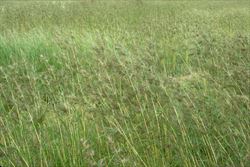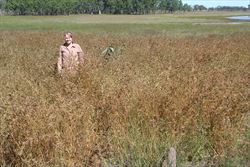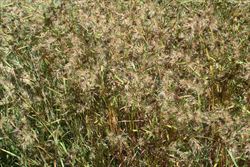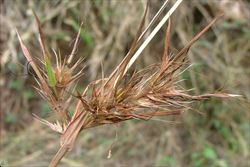Click on images to enlarge

dense infestation in flower (Photo: Chris Gardiner)

infestation in seed (Photo: Chris Gardiner)

habit in flower (Photo: Chris Gardiner)

habit in seed (Photo: Chris Gardiner)

stems and leaves (Photo: Chris Gardiner)

young seed-head with green leafy bracts (Photo: Chris Gardiner)

part of immature seed-head with green flower spikelets (Photo: Chris Gardiner)

part of mature seed-head (Photo: Sheldon Navie)

complex flower clusters containing flower spikelets and brown leafy bracts (Photo: Sheldon Navie)

close-up showing awned seeds and stiff hairs on mature flower spikelets (Photo: Sheldon Navie)
Scientific Name
Themeda quadrivalvis (L.) Kuntze
Synonyms
Andropogon quadrivalvis L.
Family
Gramineae (South Australia)Poaceae (Queensland, New South Wales, the ACT, Victoria, Tasmania, Western Australia and the Northern Territory)
Common Names
grader grass, habana grass, kangaroo grass, oatgrass
Origin
Native to the Indian sub-continent (i.e. India and Nepal) and possibly also parts of south-eastern Asia (i.e. Thailand, Vietnam, Myanmar and Indonesia).
Cultivation
Naturalised Distribution
This species is widely distributed throughout the coastal and sub-coastal regions of the Northern Territory and Queensland. Scattered populations are also found in the northern parts of Western Australia and in the coastal districts of northern New South Wales.
Also naturalised in some parts of the USA (i.e. California, Kansas, Louisiana and Florida), the Caribbean, southern South America, Africa, western Asia, China, the Mascarenes (i.e. La Réunion) and on some Pacific islands (i.e. Fiji and New Caledonia).
Habitat
A weed of roadsides, disturbed sites, waste areas, open woodlands, grasslands, pastures and crops that is mainly found in tropical and sub-tropical regions.
Habit
A short-lived (i.e. annual) tufted grass with an upright (i.e. erect) habit that usually grows 50-200 cm tall.
Distinguishing Features
- an upright and short-lived grass growing 50-200 cm tall.
- its stems, leaves and seed-heads turn reddish-brown or golden-brown in colour as they mature.
- its seed-heads consist of many drooping, fan-shaped flower clusters interspersed with short 'leaves'.
- the mature seeds (4.5-5.5 mm long) have a cluster of hairs at the base and are topped with a large twisted awn (10-45 mm long).
Seedling
The young seedlings of this species are upright (i.e. erect) with a purplish-red base. As the seedlings begin to grow they produce several spreading branches (i.e. tillers), with flattened stems and purplish-red bases.
Stems and Leaves
Plants are robust with several upright stems (i.e. erect culms) being produced from each rootstock. The stems (4-6 mm thick) are green at first, hairless (i.e. glabrous), and turn reddish-brown or golden-brown in colour as they mature.
The alternately arranged leaves consist of a leaf sheath, which partially encloses the stem, and a narrow (i.e. linear) leaf blade (7-60 cm long and 1-7 mm wide). These leaves are folded in the bud and green at first, but also turn brownish in colour with age. The leaf margins are flat or sometimes rolled under (i.e. recurved) and the leaf blades have pointed tips (i.e. acute or acuminate apices). Where the leaf sheath meets the leaf blade there is a small membranous structure (i.e. membranous ligule) 1-3 mm long.
Flowers and Fruit
The seed-heads (15-60 cm long) have several small branches that are interspersed with short 'leaves' (i.e. spathes). They turn brown or slightly reddish in colour and become somewhat drooping in nature as they mature. These seed-heads consist of several complex triangular-shaped or fan-shaped flower clusters (1-3 cm long), enclosed in leafy bracts (about 2 cm long), that contain both fertile and sterile flower spikelets. The fertile flower spikelets (5-6 mm long) are oval (i.e. elliptic) or almost cylindrical (i.e. sub-terete) in shape. They have one tiny fertile flower (i.e. floret), one tiny sterile flower, and a pair of bracts (i.e. glumes) 4.5-6 mm long. The bracts (i.e. glumes) are elongated in shape (i.e. lanceolate) and stiffly hairy (i.e. setose) in the upper half. Flowering occurs mainly during summer and autumn, but may also occur during winter.
The 'seeds' (i.e. grains or caryopses) are brown in colour with an obvious cluster of reddish hairs at the base (i.e. callus). These 'seeds' (4.5-5.5 mm long) are topped with a relatively large, conspicuous, bent and twisted, awn (10-45 mm long) and are enclosed within two hairless (i.e. glabrous), smooth, bracts (i.e. a palea and lemma).
Reproduction and Dispersal
This plant only reproduces by seed.
Seeds are spread by animals and vehicles, in clothing and mud, and as a contaminant of agricultural produce. They are also commonly dispersed during soil moving activities, such as the grading of roads (hence the common name "grader grass").
Environmental Impact
Grader grass (Themeda quadrivalvis) is regarded as an environmental weed in Queensland, the Northern Territory, northern Western Australia and north-eastern New South Wales. It was recently also listed as a priority environmental weed in two Natural Resource Management regions.
Grader grass (Themeda quadrivalvis) can significantly reduce the biodiversity of native grasslands, savanna woodlands and rangelands, particularly in areas that are overgrazed or disturbed. It replaces native plants and forms tall thickets that can cover large tracts of land. Due to its greater biomass than the native plants it replaces, and hence its higher fuel loads, grader grass (Themeda quadrivalvis ) alters the fire regime. It does this by carrying more wildfires that are of a much greater intensity than the native plants are used to. Each of these hot fires, during the late dry season, cause a thinning of the native woodlands and eventually the number of trees in the ecosystem are reduced, resulting in a change from native savanna woodlands to exotic grasslands.
It is currently causing most concern in the semi-arid rangelands of northern Queensland and the Northern Territory, where it is abundant and continuing to spread. However, it also appears in the list of the top 200 most invasive plants of south-eastern Queensland, and is in the New South Wales North Coast environmental weed list. It is also seen as a potentially significant threat to the Kimberley region in northern Western Australia, though it is not yet very widespread in this region.
Other Impacts
Younger plants are readily eaten by livestock, however flowering plants are unpalatable and rarely grazed. Because of its short period of usefulness, and propensity to outcompete more useful grasses, it can seriously reduce the productivity of pastures (both native and sown) in the tropical and semi-arid regions of northern Australia.
Grader grass (Themeda quadrivalvis) is also an important weed of crops in many parts of northern Australia. It is particularly troublesome in sugar cane, but can also be found in lucerne and other legume seed crops. It is regarded as a major weed of crops in coastal northern and central Queensland, and is also a minor crop weed in inland central Queensland and the Northern Territory.
This species is a also very common weed of roadsides, where it can quickly become a safety hazard by reducing visibility on corners.
Legislation
This species is declared under legislation in the following states and territories:
- Northern Territory: B - spread to be controlled (throughout all of the Territory), and C - not to be introduced to the Territory.
- Western Australia: Prohibited - on the prohibited species list and not permitted entry into the state.
Management
For information on the management of this species see the following resources:
- the Northern Territory Department of Natural Resources, Environment and The Arts Agnote on this species, which is available online at http://www.nt.gov.au/weeds.
Similar Species
Grader grass (Themeda quadrivalvis) is very similar to the native kangaroo grass (Themeda triandra) and reasonably similar to native oatgrass (Themeda avenacea) and lesser tanglegrass (Themeda arguens). These species can be distinguished by the following differences:
- grader grass (Themeda quadrivalvis ) is a moderately-sized to relatively large short-lived (i.e. annual) grass growing up to 1.8 m tall. Its individual flower spikelets are relatively small (4-7 mm long), stiffly hairy (i.e. setose) in the upper half, and its seeds are topped with a relatively fine awn (10-45 mm long).
- kangaroo grass (Themeda triandra ) is a moderately-sized long-lived (i.e. perennial) grass usually growing less than 1 m tall. Its individual flower spikelets are moderately-sized (6-14 mm long), hairless (i.e. glabrous) or slightly hairy (i.e. hispid), and its seeds are topped with a relatively large awn (25-70 mm long).
- native oatgrass (Themeda avenacea) is a large long-lived (i.e. perennial) grass often growing up to 2 m tall. Its individual flower spikelets are very large (13-30 mm long), densely hairy (i.e. villous), and its seeds are topped with a large and robust awn (40-100 mm long).
- lesser tanglegrass (Themeda arguens ) is a large short-lived (i.e. annual) grass growing up to 3 m tall. Its individual flower spikelets are moderately-sized (6-11 mm long), softly hairy (i.e. pubescent), and topped with a large and robust awn (50-90 mm long).

